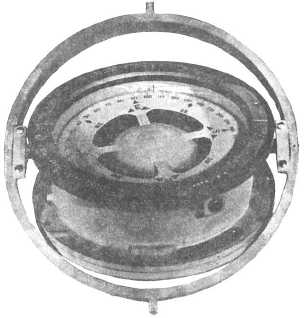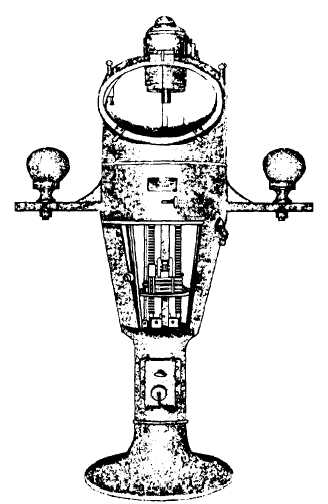| |
point faithfully and steadily to true north. But the
magnetic compass remains the reliable standby,
constantly checking the gyro's performance, and ready
always to take over if it fails.
MAGNETIC COMPASS
The magnetic compass operates through the
attraction exerted by Earth itself. Because Earth is
certain to continue to function as a magnet, the magnetic
compass has an unfailing power source.
The magnetic compass (fig. 2-2) is located in the
pilothouse. It consists of a magnetized compass needle
attached to a circular compass card, usually 7 1/2 inches
in diameter. The card and the needle are supported on a
pivot that is set in a cast bronze bowl filled with a
petroleum distillate fluid similar to Varsol. This liquid
buoys up the card and the magnet. The buoyancy will
take some of the load off the pivot, thereby reducing the
friction and letting the card turn more easily on the pivot.
At the same time, the liquid slows the swing of the card
and brings it to rest more quickly. Marked on the
compass bowl is a line, called the lubber's line, which
agrees with the fore-and-aft line of the ship or boat. By
reading the compass card's direction lined up with the
lubber's line, you can tell the direction the ship is
heading.
The card remains stationary, pointing at the
magnetic pole which is a north-south line lined up with
the north-south (magnetic) directions on Earth. When
you are steering, always remember that the ship turns
under the card.
Figure 2-2.— Navy standard 7 1/2-Inch compass.
2-2
The compass bowl is mounted in a system of double
rings on bearings, known as gimbals, permitting the
compass card to ride flat and steady no matter how the
ship may roll. In turn, the gimbal rings are mounted in
a stand called the binnacle (fig. 2-3). The Navy uses a
compensating binnacle, on which two spheres of soft
iron are mounted on arms, one on either side of the
compass. The spheres are adjusted to counteract some
of the deviation (covered later in this chapter). To
correct for other local magnetic forces that make up the
deviation, small magnets are located within the
binnacle, directly below the compass. The binnacle is
positioned forward of the wheel, where it can best be
seen by the helmsman.
The compass card is divided into 360°, numbered
all the way around in a clockwise direction.
A true course to be steered can be converted into a
magnetic compass course by adding or subtracting
variation for the area and deviation for the compass on
Figure 2-3.— Navy standard magnetic compass binnacle.
|


